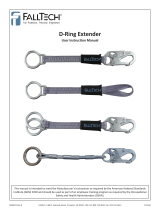
1. Compliant fall protection and emergency rescue systems help prevent serious injury
during fall arrest. Users must read and understand the User Instructions provided with
the product and be properly trained by their employer prior to use per OSHA 29 CFR
1910.66 and 1926.503 or applicable local standards. Misuse or failure to follow warnings
and instructions may result in serious personal injury or death. For proper use, see
supervisor, User Instructions, or call Technical Service at 800-243-4630.
2. Failure to follow all instructions and limitations on the use of Personal Energy Absorbers and
Energy Absorbing Lanyards may result in serious personal injury or death.
3. Minors, pregnant women and anyone with a history of either back or neck problems should
not use this equipment.
4. Do not use or install equipment without proper training from a “competent person” as defi ned
by OSHA 29 CFR 1926.32(f).
5. Personal Energy Absorbers and Energy Absorbing Lanyards are designed for a single user.
6. Energy Absorbing Lanyards must not be wrapped around structural members and connected
back onto themselves, unless the lanyard has been specifi cally designed to do so.
7. Caution must be taken when using Personal Energy Absorbers and Energy Absorbing
Lanyards near moving machinery, electrical hazards, sharp edges, or abrasive surfaces.
Contact with these elements may cause equipment failure, personal injury, or death.
8. Do not expose Personal Energy Absorbers and Energy Absorbing Lanyards to chemicals or
harsh solutions which may have a harmful effect. Contact 3M Technical Service with any
questions.
9. Personal fall arrest systems, including Personal Energy Absorbers and Energy Absorbing
Lanyards, must be inspected prior to each use for wear, damage and other deterioration, and
defective components must be immediately removed from service, in accordance with the
requirements of OSHA 29 CFR 1910.66 and 1926.502.
10. Personal Energy Absorbers and Energy Absorbing Lanyards are designed to be used in
temperatures ranging from -40ºF to +130ºF (-40°C to +54°C).
11. Striking objects horizontally due to the pendulum affect of a swing fall may cause serious
injury or death.
12. The addition of the 2 foot (0.6 m) 3012 Personal Energy Absorber will increase the clearance
requirements by 5½ feet (1.6 m). The additional distance must be taken into consideration
during the clearance calculation process.
13. Only lanyards with captive eye carabiners and TyBak webbing are approved for tie-back
directly onto the webbing.
14. Never attach the unused leg of the lanyard back to the harness at any location other than a
lanyard storage keeper.
15. If inspection reveals any defect, wear, damage, deterioration, inadequate maintenance, or
unsafe condition, immediately remove from service and destroy.
GENERAL SAFETY INFORMATION
Under Penalty of Law
These User Instructions are not to be removed except by the user of this equipment. Current
User Instructions must always be available to the user.
WARNING
2

















